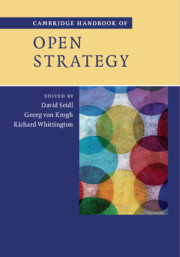Book contents
- Cambridge Handbook of Open Strategy
- Cambridge Handbook of Open Strategy
- Copyright page
- Contents
- Figures
- Tables
- Introduction
- Part I The Concept of Open Strategy
- Part II Practices of Open Strategy
- Part III Technological Assemblages for Open Strategy
- Part IV Theoretical Perspectives
- Part V Challenges of Open Strategy
- Index
- References
Part IV - Theoretical Perspectives
Published online by Cambridge University Press: 13 July 2019
- Cambridge Handbook of Open Strategy
- Cambridge Handbook of Open Strategy
- Copyright page
- Contents
- Figures
- Tables
- Introduction
- Part I The Concept of Open Strategy
- Part II Practices of Open Strategy
- Part III Technological Assemblages for Open Strategy
- Part IV Theoretical Perspectives
- Part V Challenges of Open Strategy
- Index
- References
Summary
Practice theories have an obvious appeal for Open Strategy research. The major trend towards more openness in strategy making gives rise to new strategy practices that afford internal and external actors greater strategic transparency and/or inclusion (Whittington et al., 2011). Committing to the primacy of practice in social life (Reckwitz, 2002; Schatzki et al., 2001), practice theories offer a particularly suitable perspective for studying both the emergence of these new Open Strategy practices and the complex dynamics of their application in real-life settings. Accordingly, many studies on Open Strategy already refer to practice theories to identify the new practices associated with Open Strategy, such as strategy jamming, strategy blogging, or interorganizational strategy making.
- Type
- Chapter
- Information
- Cambridge Handbook of Open Strategy , pp. 219 - 304Publisher: Cambridge University PressPrint publication year: 2019
References
References
References
References
References
References
ChinaMobile [www.chinamobileltd.com/en/about/cg.php; access: 14.11.2016]
ChinaMobile [www.chinamobileltd.com/en/file/view.php?id=121340; access: 14.11.2016]
ChinaMobile [www.chinamobileltd.com/en/ir/reports/ar2013/E8.pdf; access: 14.11.2016]
Daimler AG [www.daimler.com/Projects/c2c/channel/documents/1488194_AI_2007_Annual_Report.pdf; access: 14.11.2016]
Gazprom [www.gazprom.com/about/strategy/exploration/; access: 14.11.2016]
Gazprom [www.gazprom.com/f/posts/53/331565/sustainability-report-2011-en.pdf; access: 14.11.2016]
Gazprom [www.gazprom.com/press/news/2016/february/article266959/; access: 14.11.2016]
Pfizer Inc. [www.pfizer.com/research/research_clinical_trials/laboratory_animal_care; access: 14.11.2016]
The Coca-Cola Company [http://transparency.coca-colajourney.com.au/frequently-asked-questions; access: 14.11.2016]
The Coca-Cola Company [www.coca-colacompany.com/our-company/addressing-global-issues#6; access: 14.11.2016]
Internet Addresses
ChinaMobile [www.chinamobileltd.com/en/about/cg.php; access: 14.11.2016]
ChinaMobile [www.chinamobileltd.com/en/file/view.php?id=121340; access: 14.11.2016]
ChinaMobile [www.chinamobileltd.com/en/ir/reports/ar2013/E8.pdf; access: 14.11.2016]
Daimler AG [www.daimler.com/Projects/c2c/channel/documents/1488194_AI_2007_Annual_Report.pdf; access: 14.11.2016]
Gazprom [www.gazprom.com/about/strategy/exploration/; access: 14.11.2016]
Gazprom [www.gazprom.com/f/posts/53/331565/sustainability-report-2011-en.pdf; access: 14.11.2016]
Gazprom [www.gazprom.com/press/news/2016/february/article266959/; access: 14.11.2016]
Pfizer Inc. [www.pfizer.com/research/research_clinical_trials/laboratory_animal_care; access: 14.11.2016]
The Coca-Cola Company [http://transparency.coca-colajourney.com.au/frequently-asked-questions; access: 14.11.2016]
The Coca-Cola Company [www.coca-colacompany.com/our-company/addressing-global-issues#6; access: 14.11.2016]

